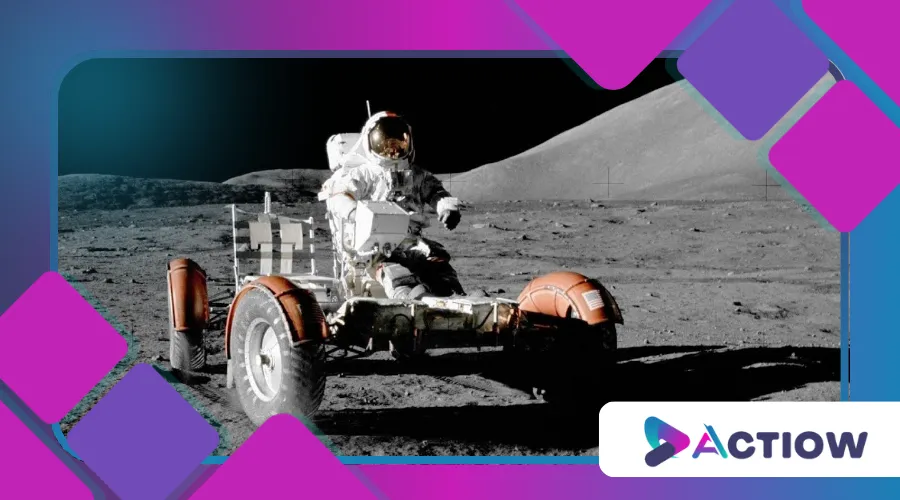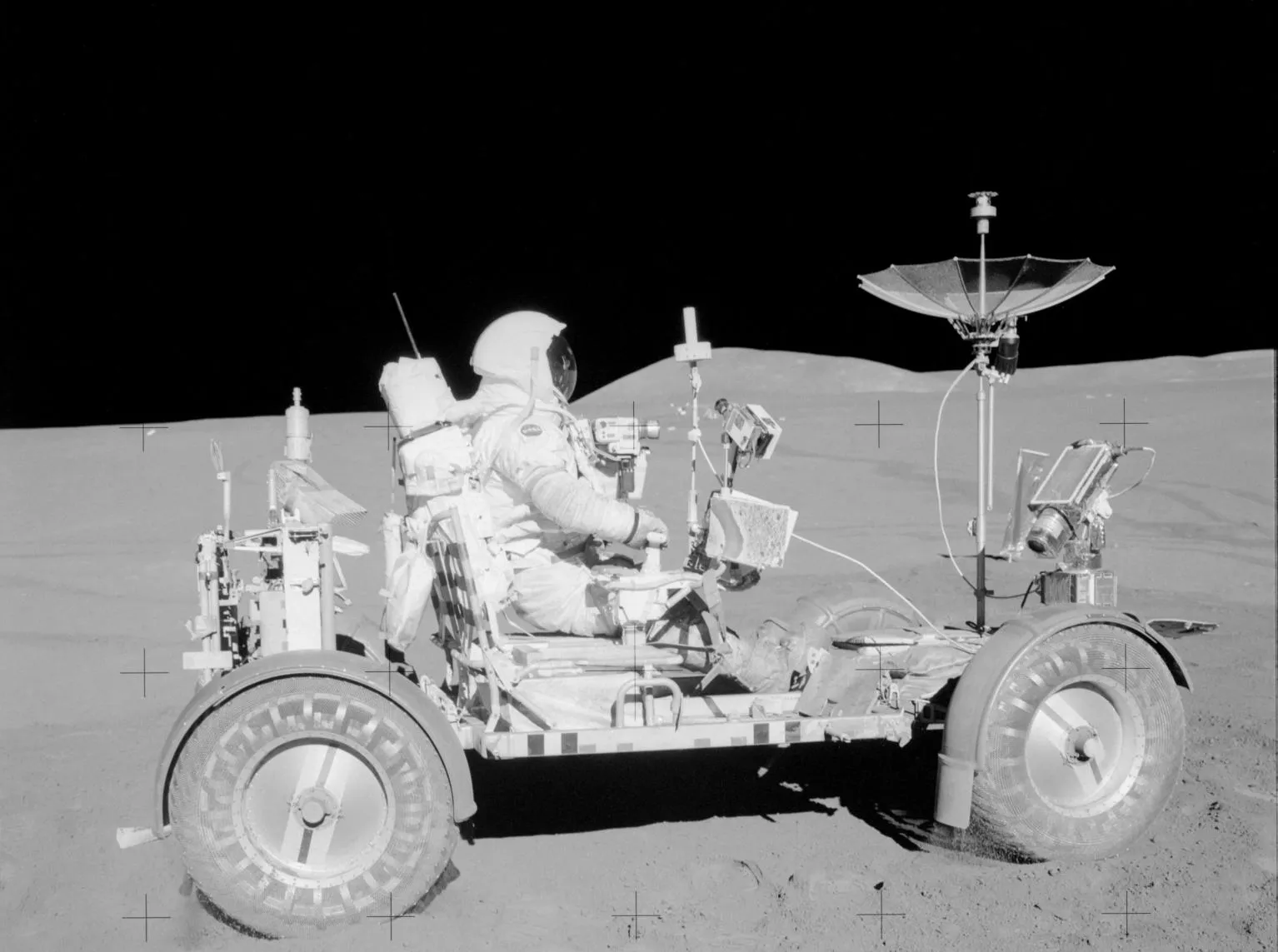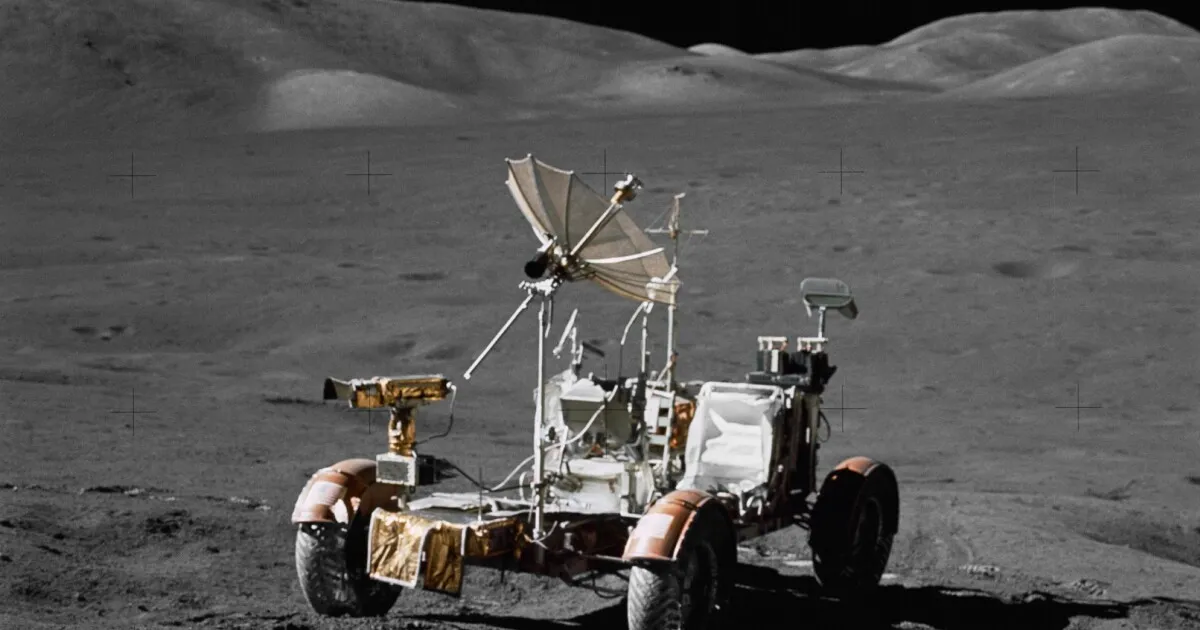The Car That Drove on the Moon: The Untold Story of the Lunar Rover

Anúncios
The car that drove on the moon wasn’t just a vehicle; it was a triumph of human ingenuity, a four-wheeled testament to our relentless pursuit of exploration.
In the early 1970s, NASA’s Apollo missions introduced the Lunar Roving Vehicle (LRV), a machine that forever changed how we explored extraterrestrial landscapes.
Yet, its story remains largely untold, overshadowed by the grandeur of moon landings.
Anúncios
This article dives into the riveting narrative of the Lunar Rover, exploring its engineering marvels, cultural impact, and enduring legacy in modern space exploration.
Buckle up as we traverse the moon’s dusty trails and uncover why this unsung hero deserves its spotlight.
A Moon Buggy Born from Necessity
Imagine the challenge: you’ve landed humans on the moon, but their mobility is limited to cumbersome spacewalks.
How do you expand their reach across the lunar surface?
NASA faced this question in the late 1960s as Apollo missions evolved from brief visits to extended scientific expeditions.
The solution was the Lunar Rover, a compact, electric-powered vehicle designed to navigate the moon’s harsh terrain.
Unlike Earth-bound cars, the LRV had to withstand extreme temperatures, operate in a vacuum, and function under one-sixth of Earth’s gravity.
The car that drove on the moon was a collaborative effort led by Boeing and General Motors, with contributions from aerospace engineers and scientists.
Development began in 1969, with a tight 17-month deadline to deliver a vehicle for Apollo 15 in 1971.
The LRV weighed just 460 pounds on Earth but could carry over 1,000 pounds of payload on the moon, thanks to its low-gravity environment.
Its foldable design allowed it to fit inside the Apollo Lunar Module, unfolding like a high-tech origami masterpiece once on the lunar surface.
This innovative design not only solved immediate mobility issues but also inspired future advancements in vehicle engineering.
The principles behind the LRV’s design have influenced the development of various rovers used in space exploration today.
Engineering the Impossible
The Lunar Rover’s design was a masterclass in problem-solving.
Its wheels, crafted from woven steel mesh with titanium chevrons, provided traction on the moon’s powdery regolith while avoiding excess weight.
Each wheel had its own electric motor, ensuring redundancy—if one failed, the others could keep the rover moving.
The vehicle’s top speed was a modest 8.7 mph, but in the moon’s low gravity, astronauts described the ride as thrilling, akin to a cosmic dune buggy.
Powering the car that drove on the moon were two 36-volt silver-zinc batteries, delivering enough juice for up to 57 miles of travel.
In reality, the rovers never exceeded 22.3 miles per mission, as astronauts stayed within a safe distance from their lunar module.
The LRV’s navigation system, primitive by today’s standards, relied on a directional gyroscope and odometer, allowing astronauts to track their position without GPS—a technology still decades away.
| Lunar Rover Specifications | Details |
|---|---|
| Weight (Earth) | 460 lbs |
| Payload Capacity (Moon) | 1,080 lbs |
| Top Speed | 8.7 mph |
| Range | 57 miles |
| Power Source | Two 36V silver-zinc batteries |
| Wheel Material | Woven steel mesh with titanium chevrons |
Moreover, the engineering challenges faced in developing the LRV have paved the way for new materials and technologies in automotive and aerospace industries.
Engineers continue to study the LRV’s design for insights into lightweight structures and efficient energy use.
+ The History of Audi: Technology and Innovation on Four Wheels
The Human Touch on Alien Soil
The Lunar Rover wasn’t just a machine; it was an extension of human curiosity.
During Apollo 15, 16, and 17, astronauts like David Scott and Eugene Cernan used the car that drove on the moon to explore craters, collect samples, and conduct experiments that reshaped our understanding of lunar geology.
For instance, during Apollo 15 in 1971, the LRV enabled astronauts to travel 17.3 miles, collecting 170 pounds of lunar material, including the famous “Genesis Rock,” a 4.5-billion-year-old anorthosite sample.
One vivid example of the rover’s impact comes from astronaut John Young’s experience on Apollo 16.
While navigating the Descartes Highlands, Young used the LRV to reach a distant boulder field, discovering unexpected volcanic rocks.
Without the rover, such a journey would have been impossible within the mission’s tight oxygen constraints.
Another moment of brilliance occurred during Apollo 17, when Eugene Cernan repaired a damaged fender using duct tape and lunar maps, ensuring the car that drove on the moon could continue its mission without kicking up blinding dust clouds.
These personal stories highlight the profound connection between astronauts and the technology they use, showcasing the human spirit of innovation and resilience.
As astronauts faced challenges, their adaptability and creativity often turned potential setbacks into opportunities for discovery.

A Cultural Icon in the Cosmos
Beyond its scientific contributions, the Lunar Rover captured the public’s imagination.
In the 1970s, as America grappled with social upheaval and the Vietnam War, the LRV symbolized hope and progress.
Live television broadcasts showed astronauts zipping across the moon, their tire tracks etching human ambition into the lunar soil.
The rover became a pop culture touchstone, inspiring everything from toy models to sci-fi novels.
It was the ultimate road trip, a journey that made the impossible feel attainable.
Consider this analogy: the Lunar Rover was to the Apollo missions what a trusty steed was to a medieval explorer—reliable, versatile, and indispensable.
Just as a knight’s horse carried them through uncharted lands, the LRV empowered astronauts to venture farther, faster, and with greater purpose.
Its tire tracks, still preserved on the moon’s airless surface, are a silent reminder of humanity’s audacity.
In fact, the Lunar Rover has inspired numerous documentaries and films, reflecting its significance in both history and culture.
For more information on its impact, you can visit the NASA website for detailed mission accounts.
Challenges and Triumphs
Building the car that drove on the moon was no small feat.
Engineers faced a litany of challenges, from weight constraints to thermal extremes ranging from -280°F to 260°F.
The LRV’s aluminum frame and non-pneumatic tires were designed to endure these conditions, but testing on Earth could only simulate so much.
During Apollo 15, astronauts discovered the rover’s front steering was sluggish, requiring on-the-fly adjustments.
Yet, the vehicle’s robustness shone through, completing all three missions without catastrophic failure.
A 2021 study by NASA’s Jet Propulsion Laboratory highlighted the LRV’s efficiency, noting that it increased astronaut productivity by 300% compared to foot-based exploration.
This statistic underscores the rover’s transformative impact, enabling missions to cover more ground and collect diverse samples.
Without the LRV, the scientific yield of Apollo 15, 16, and 17 would have been a fraction of what it was.
| Lunar Rover Mission Performance | Apollo 15 | Apollo 16 | Apollo 17 |
|---|---|---|---|
| Distance Traveled (miles) | 17.3 | 16.6 | 22.3 |
| Samples Collected (lbs) | 170 | 211 | 243 |
| Mission Duration (hours) | 18.3 | 20.2 | 22.0 |
Furthermore, the challenges encountered during the LRV’s missions have informed the design and testing of future space vehicles.
Lessons learned about durability and adaptability continue to shape engineering practices in the aerospace industry.

The Legacy in Modern Space Exploration
Why should we care about a vehicle from half a century ago?
The car that drove on the moon laid the groundwork for today’s extraterrestrial rovers, from Mars’ Perseverance to China’s Yutu-2.
Its modular design and rugged engineering informed NASA’s development of autonomous rovers, which now rely on AI and advanced sensors.
The LRV’s success proved that mobility is key to exploration, a lesson driving current plans for crewed missions to Mars and beyond.
For example, NASA’s Artemis program, aiming to return humans to the moon by 2026, includes plans for a modern lunar rover.
Unlike its Apollo predecessor, this new vehicle will incorporate solar power and autonomous navigation, but its core mission echoes the LRV: to expand human reach.
Private companies like SpaceX and Intuitive Machines are also drawing inspiration from the LRV, developing rovers for commercial lunar missions.
The car that drove on the moon remains a blueprint for innovation.
In addition, the legacy of the LRV continues to inspire educational programs and initiatives aimed at fostering interest in STEM fields.
By showcasing its achievements, educators can motivate the next generation of engineers and scientists to push the boundaries of exploration.
++ Cars Designed to Defy Gravity
The Untold Human Stories
The Lunar Rover’s story isn’t just about technology; it’s about the people who made it possible.
Engineers like M.G. Bekker, a soil mechanics expert, pioneered the LRV’s wheel design by studying lunar soil simulants.
Astronauts, too, formed a bond with the rover, nicknaming it their “moon buggy.”
During Apollo 17, Eugene Cernan left a poignant message: “The last man on the moon bids you farewell.”
The LRV, parked silently beside the lunar module, became a monument to that era’s ambition.
The rover also sparked philosophical questions.
What does it mean to leave human-made objects on another world?
The LRV’s tire tracks, undisturbed by wind or rain, are a time capsule of our presence.
They challenge us to consider our place in the cosmos and our responsibility as explorers.
Moreover, the stories of the individuals involved in the LRV’s creation and operation highlight the collaborative nature of space exploration.
Each contribution, no matter how small, played a vital role in achieving this monumental feat.
Looking to the Stars
The car that drove on the moon is more than a historical footnote; it’s a catalyst for dreaming bigger.
Its story reminds us that innovation thrives under constraints, that collaboration can conquer the impossible, and that exploration is a deeply human endeavor.
As we stand on the cusp of a new space age, with lunar bases and Mars missions on the horizon, the LRV’s legacy endures.
It’s a call to action—a challenge to build the next vehicle that will carry us to uncharted worlds.
So, what will the next car that drove on the moon look like?
Will it be a sleek, AI-driven rover or a rugged beast built for Martian storms?
Whatever form it takes, the Lunar Rover’s spirit will guide it, proving that no terrain is too alien, no dream too distant.
The moon’s tire tracks are just the beginning.
